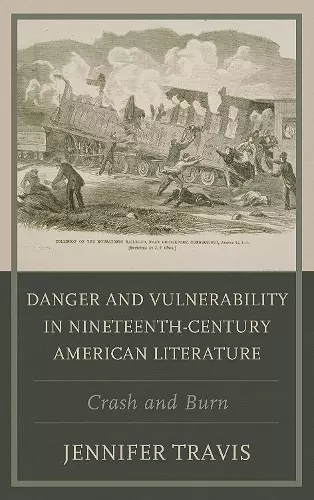Danger and Vulnerability in Nineteenth-century American Literature
Crash and Burn
Format:Hardback
Publisher:Bloomsbury Publishing PLC
Published:12th Mar '18
Currently unavailable, and unfortunately no date known when it will be back
This hardback is available in another edition too:
- Paperback£35.00(9781498563437)

Nineteenth-Century Americans saw danger lurking everywhere: in railway cars and trolleys, fireplaces and floods, and amid social and political movements, from the abolition of slavery to suffrage. After the Civil War, Americans were shaken by financial panic and a volatile post-slave economy. They were awe-struck and progressively alarmed by technological innovations that promised speed and commercial growth, but also posed unprecedented physical hazard. Most of all, Americans were uncertain, particularly in light of environmental disasters like hurricanes and wildfires, about their own city on a hill and the once indisputable and protective hand of a beneficent God. The disasters, accidents, and social and political upheavals that characterized nineteenth-century culture had enormous explanatory power, metaphoric and real.
Today we speak of similar insecurities: financial, informational, environmental, and political, and we obsessively express our worry and fear for the future. Cultural theorist Paul Virilio refers to these feelings as the “threat horizon,” one that endlessly identifies and produces new dangers.Why, he asks, does it seem easier for humanity to imagine a future shaped by ever-deadlier accidents than a decent future? Danger and Vulnerability in Nineteenth Century American Literature; or, Crash and Burn American invites readers to examine the “threat horizon” through its nascent expression in literary and cultural history. Against the emerging rhetoric of danger in the long nineteenth century, this book examines how a vocabulary of vulnerability in the American imaginary promoted the causes of the structurally disempowered in new and surprising ways, often seizing vulnerability as the grounds for progressive insight. The texts at the heart of this study, from nineteenth-century sensation novels to early twentieth-century journalistic fiction, imagine spectacular collisions, terrifying conflagrations, and all manner of catastrophe, social, political, and environmental. Together they write against illusions of inviolability in a growing technological and managerial culture, and they imagine how the recognition of universal vulnerability may challenge normative representations of social, political, and economic marginality.
Travis (St. John’s Univ.) bookends this innovative study of environmental disasters and apocalyptic circumstances in American literature of the late 19th century with Fenimore Cooper’s The Crater (1847) and the San Francisco earthquake and fire (1906), along the way scrutinizing little-known works by canonical authors and neglected others. Readers may find surprises here: E. D. E. N. Southworth, Mark Twain, Jack London, Kate Chopin, Theodore Dreiser, W. E. B. Du Bois—all wrote “crash" narratives about fires, human monstrosities, celestial events, earthquakes, and so on. Travis does not portray trauma for its own sake; she details how writers created scenes of fearful dangers brought about by nature. In her fifth and final chapter, “The Tremblor,” she restores appreciation for Mary Hunter Austin’s essay about the San Francisco earthquake and H. T. Lamey’s insurance theme in his novel Side Lights (1906). Travis contributes to the trend in spiritualist and machine-inspired culture history examined by scholars such as Bridget Bennett (Transatlantic Spiritualism and Nineteenth Century American Literature, CH, Jan'08, 45-2458) and Katherine Biers (Virtual Modernism, CH, Jun'14, 51-5441), looking at how catastrophe, technology, and social justice intersect. Buttressed by relevant scholarship and prodigious references, Travis's argument will make a significant and lasting imprint on American cultural studies.
Summing Up: Highly recommended. Lower-division undergraduates and above; general readers.
Jennifer Travis’s deeply-researched study examines how nineteenth-century Americans sought to guard against the very technology that they hoped would keep them safe. Moving from sentimental novels to medical, sociological and business texts, Travis skillfully charts Americans’ ongoing fear of vulnerability, and the lengths to which they would go to avoid it. This book has much to offer nineteenth-century scholars, but It also offers rich insight into our current struggle to negotiate technology’s risks and rewards. -- Anna Mae Duane, University of Connecticut
Jennifer Travis has written an important, groundbreaking book that will generate much discussion. Her command of scholarship beyond literary studies is extraordinary. -- Paul Sorrentino, Virginia
ISBN: 9781498563413
Dimensions: 242mm x 157mm x 17mm
Weight: 435g
174 pages